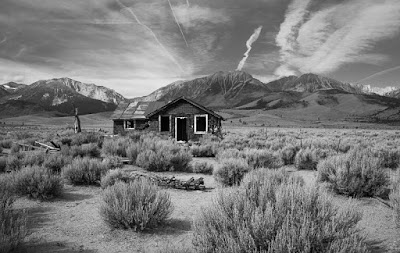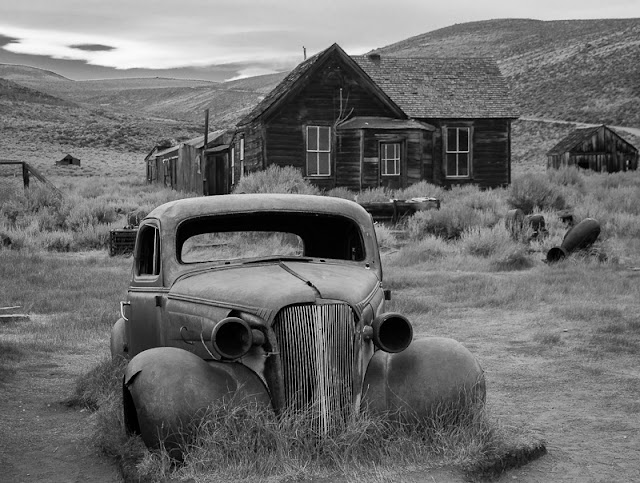 |
| YES, 3 MILES ON A VERY BUMPY DIRT ROAD |
This visit was different because now 10 of the 13 miles of the access road are paved. This meant we only had to drive three miles on a dusty washboard with deep ruts and potholes. The nicely paved road made our drive in much faster and certainly more comfortable. I'm pretty sure that 40 years ago we were the only people visiting Bodie at the time because it was not well known like it is today, now that it is a California State Park and a National Historic site. Last week when we reached the end of the road and the town's entrance, we came upon a gatehouse where a ranger collected a small fee, handed us a map and brochure, and directed us uphill to a paved parking lot where there were also important amenities like flush toilets. He also said we had two and a half hours before the park closed, which seemed like plenty of time for us to explore the abandoned town. There were a few visitors like us exploring the streets, peering into windows, and in some cases going inside some of the houses where remnants of the past were visible in paint-faded furniture, moth-eaten mattresses and broken doors that hung loosely, many unhinged. Almost everyone had a camera.
 |
| MAIN STREET |
Bodie began as a mining camp, following the discovery of gold in 1859 and was named after Bill Bodey, one of the four prospectors who discovered the gold but never got to see the glorious rise of the town because he perished in a blizzard just a few months after establishing the camp. The mining of gold and the glory of Bodie waxed and waned over the next ten to fifteen years, but in 1876 a profitable deposit of gold-bearing ore was discovered, and Bodie was transformed from an isolated mining camp to a wild west boomtown. By 1879 Bodie had a population of approximately 5,000-7,000 people. As a bustling gold mining center, Bodie offered many services of a larger town, such as a Wells Fargo Bank, a volunteer fire department, a brass band, a railroad and a well-used jail. At its peak, 65 saloons lined main street which was a mile long. Murders, shootouts, bar room brawls and stagecoach holdups were regular occurrences in Bodie. There were hundreds of bearded miners, who came to town to seek their fortunes in the gold mine but spent their nights in the saloons, looking for quick money or simply getting into trouble and landing in jail. Many of them looked like this old timer whose photo I took in the historic gold country town of Columbia just off Highway 49.
 |
| AN OLD TIMER WHO PROBABLY RESEMBLES THE FORTUNE SEEKERS OF BODIE |
 |
| LISTING TO THE LEFT SLIGHTLY |
 |
| THE BEAUTY OF DECAY |
Living conditions in Bodie were crude and primitive, but the people in town were generous and kind, which helped Bodie thrive during the tough years, when gold became harder to mine and fortune seekers moved to other boom towns, hoping once again to get rich quick. These changes eventually turned Bodie into a family-oriented community, as evidenced by the construction of the Methodist Church, which still stands, and the Roman Catholic Church that later burned down. Despite the decline, Bodie had permanent residents through the early years of the 20th century even after the fire in 1932 that burned down 70% of the town.
 |
| METHODIST CHURCH STILL STANDS |
 |
The title of ghost town was given to Bodie in 1915 when auto travel was on the rise, and people from all over came to visit after reading a story about the abandoned mining town published in the San Francisco Chronicle.
In the 1940s the threat of vandalism faced Bodie, but the family who owned much of the town's land at that time hired caretakers to protect and maintain the town's structures, but no restoration had ever taken place.
Bodie is now an authentic wild west ghost town, designated a National Historic Landmark in 1961 and a State Historic Park in 1962. Bodie is called a ghost town because it is preserved in a state of arrested decay. This means that structures are maintained but only to the extent that they will not be allowed to fall over or otherwise deteriorate in any major way. In addition new roofs, the rebuilding of foundations and the resealing of glass in window frames does help to preserve the town from natural decay. After the 1932 fire, only a small part of the town survived, with about 110 structures.
Bruce and I hurriedly walked the deserted streets of a town that was once bustling with activity, and while initially two and a half hours seemed like sufficient time to enjoy our visit, we left feeling a bit disappointed and frustrated because there was so much to see and so many photographs to take that we could have spent the entire day. It goes without saying that we are hooked on Bodie. Bruce and I will return in the spring, after the snow melts, so we can negotiate the steep mountain passes required to reach the Eastern side of the Sierra Nevada Mountains and have another magical experience of the spooky ghost town called Bodie.
 |
| EASTERN SIDE OF THE SIERRAS |









